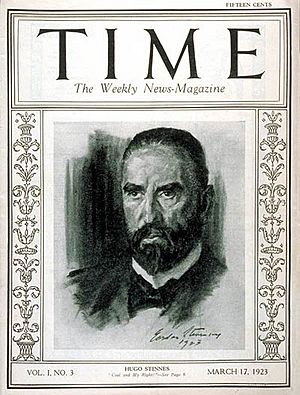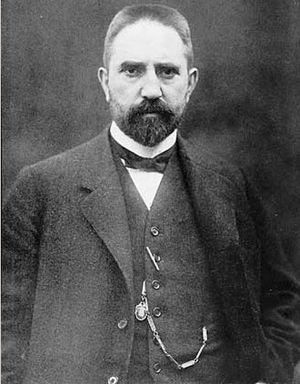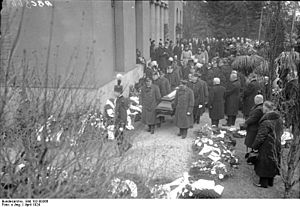Hugo Stinnes facts for kids
Quick facts for kids
Hugo Stinnes
|
|
|---|---|
 |
|
| Born |
Hugo Dieter Stinnes
12 February 1870 |
| Died | 10 April 1924 (aged 54) |
| Nationality | German |
| Occupation | Industrialist |
Hugo Dieter Stinnes (born February 12, 1870 – died April 10, 1924) was a very important German businessman and politician. He was known as one of the most powerful entrepreneurs in Europe during the time of the German Empire and the early Weimar Republic.
Contents
Who Was Hugo Stinnes?
His Early Life and Education
Hugo Stinnes was born in Mülheim, a town in the Ruhr Valley of Germany. His family, including his parents Hermann and Adeline, and his grandfather Matthias, had started a small business there.
After finishing secondary school, young Hugo went to an office in Koblenz. There, he learned about business. To understand mining better, he worked for a few months as a miner. In 1889, he studied at the Academy of Mining in Berlin. When he was just 20 years old, in 1890, he took over his father's coal mining and other businesses.
Building a Business Empire
Hugo Stinnes started in the coal industry. But he didn't stop there! He soon bought his own shipyard. He also began to buy many ships, including ocean-going vessels and river boats. These boats helped him move goods, especially on the Rhine River.
He then created a large international business for coal. He had 13 steamers that traveled to and from ports in the North Sea, Baltic Sea, Mediterranean Sea, and Black Sea. They carried coal, wood, grain, and iron ore. By the time he was 23, Stinnes had also invested a lot in the steel industry. He even imported a lot of English coal and had offices in England. This led him to open more business branches in Hamburg and Rotterdam.
Since 1898, Stinnes was on the board of directors for a big electricity company called Rheinisch-Westfälisches Elektrizitätswerk Aktiengesellschaft (RWE). He had a smart idea: use the steam from his mines to create electricity. When Stinnes saw how much potential RWE had, he and another steel leader, Fritz Thyssen, bought enough shares to become the main owners. RWE grew quickly because communities gave them permission to build power plants. To make sure these permissions lasted, he made the communities permanent shareholders. He even gave each mayor a car!
Business During World War I
Before World War I began, Hugo Stinnes was already very wealthy. He was a director for many of the biggest industrial and mining companies in Germany and Luxembourg. His businesses were always growing. He also became involved in other companies, like tramways and supplying electricity. He was always starting new companies or combining existing ones.
Stinnes was very good at knowing the details of all his businesses. He made sure everyone working for him was dedicated and hardworking. His secret to success was called vertical integration. This means he owned many different parts of a business, from getting raw materials to making and selling the final product. This helped him control everything and work efficiently.
During World War I, Stinnes gained a huge amount of money from war-related profits. His businesses in enemy countries were taken over, but he was well-paid by the German government. He was also asked by military leaders to help organize coal and industrial production in occupied Belgium. He helped to produce a huge amount of war materials.
During the war, Stinnes expanded his businesses in Hamburg. In 1916, he bought two large shipping companies. He also worked with Germany's two biggest shipping companies. His businesses in Hamburg continued to grow rapidly. He bought several land estates to get wood for his mines. In Flensburg, he took control of the largest shipping company in the Baltic Sea. He then started building a new fleet of ships.
His Role in Politics

Hugo Stinnes became an important figure in German politics. He was a strong supporter of business and conservative ideas. In 1918, he helped start the Deutsche Volkspartei (German People's Party or DVP). This party was the new name for an older political group.
After the German Revolution, in June 1920, Stinnes was elected to the Reichstag, which was the German parliament. He spoke for German industry when dealing with trade unions. He helped create the system of cooperation between unions and employers that Germany uses today. For example, the introduction of the eight-hour day was a big step.
Around the time he was elected to the Reichstag, Stinnes started buying major German newspapers. He wanted to create a strong voice in Germany that supported law and order. He also wanted to promote high industrial and business efficiency. His newspaper purchases included the Deutsche Allgemeine Zeitung in Berlin, which was once a very important government newspaper. He also bought the Münchener Neueste Nachrichten and the München-Augsburger Zeitung. To make sure his newspapers always had paper, Stinnes also bought large interests in paper mills.
Later Years and Legacy
By the early 1920s, Stinnes also used his influence in the press to criticize the Versailles Treaty. This treaty had set harsh terms for Germany after World War I. During a time when money in Germany was losing its value very quickly, Stinnes used his access to foreign money. He borrowed huge amounts of German money, then paid back these loans later with money that was almost worthless. This earned him the nickname "Inflationskönig" (Inflation King). In 1923, the American magazine Time called him "The New Emperor of Germany." This showed how much political power and wealth he had.
In the 1920s, Stinnes had a legal disagreement with Mayer Wilderman. Wilderman had started factories in Germany in 1912. When World War I began, Stinnes took over these factories. He said Wilderman was an "enemy alien." After the war, Wilderman tried to get his businesses back. However, Stinnes made the process very difficult.
Hugo Stinnes died in Berlin after a gall bladder operation. Even though his business empire included about 4,500 companies and 3,000 factories, it fell apart within a year of his death. However, parts of his empire continued on. These include Stinnes AG (now part of DB Mobility Logistics), Hugo Stinnes Schiffahrt (a shipping company), and RWE, which is still one of Germany's largest energy suppliers.
His Family
In 1895, Hugo Stinnes married Cläre Wagenknecht. They had seven children: Edmund Hugo, Hugo Hermann, Clärenore, Otto, Hilde, Ernst, and Else. Their daughter Clärenore was famous for being the first European woman to drive around the world in a car in 1929.
His son Edmund Stinnes was a financier. He left Germany and later offered his home for important secret surrender talks in 1945. These talks helped bring World War II to an end in Italy.
See also
 In Spanish: Hugo Stinnes para niños
In Spanish: Hugo Stinnes para niños




